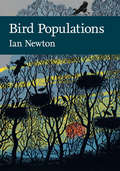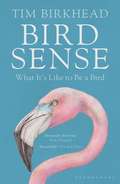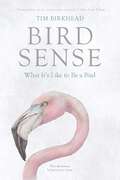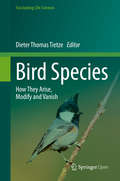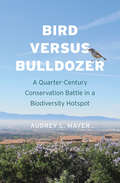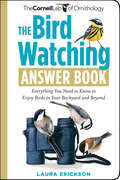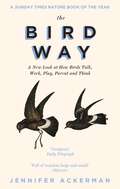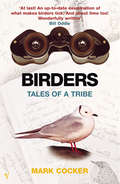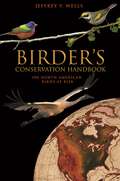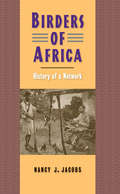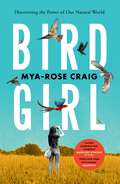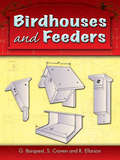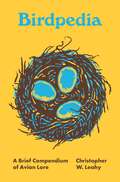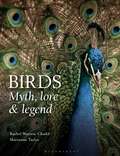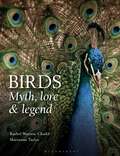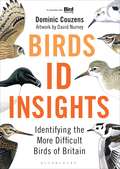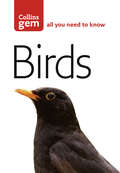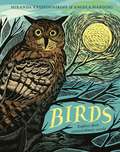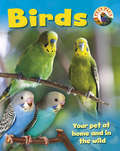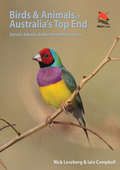- Table View
- List View
Bird Populations (Collins New Naturalist Library #124)
by Ian NewtonIn the latest addition to the New Naturalist series, Ian Newton explores bird populations and what causes their fluctuation – food supplies, competitors, predators, parasites, pathogens and human activity.
Bird Sense: What It's Like to Be a Bird
by Tim BirkheadWhat is it like to be a swift, flying at over one hundred kilometres an hour? Or a kiwi, plodding flightlessly among the humid undergrowth in the pitch dark of a New Zealand night? And what is going on inside the head of a nightingale as it sings, and how does its brain improvise? Bird Sense addresses questions like these and many more, by describing the senses of birds that enable them to interpret their environment and to interact with each other. Our affinity for birds is often said to be the result of shared senses - vision and hearing - but how exactly do their senses compare with our own? And what about a birds' sense of taste, or smell, or touch or the ability to detect the earth's magnetic field? Or the extraordinary ability of desert birds to detect rain hundreds of kilometres away - how do they do it? Bird Sense is based on a conviction that we have consistently underestimated what goes on in a bird's head. Our understanding of bird behaviour is simultaneously informed and constrained by the way we watch and study them. By drawing attention to the way these frameworks both facilitate and inhibit discovery, it identifies ways we can escape from them to seek new horizons in bird behaviour. There has never been a popular book about the senses of birds. No one has previously looked at how birds interpret the world or the way the behaviour of birds is shaped by their senses. A lifetime spent studying birds has provided Tim Birkhead with a wealth of observation and an understanding of birds and their behaviour that is firmly grounded in science.
Bird Sense: What It's Like to Be a Bird
by Tim BirkheadWhat is it like to be a swift, flying at over one hundred kilometres an hour? Or a kiwi, plodding flightlessly among the humid undergrowth in the pitch dark of a New Zealand night? And what is going on inside the head of a nightingale as it sings, and how does its brain improvise?Bird Sense addresses questions like these and many more, by describing the senses of birds that enable them to interpret their environment and to interact with each other. Our affinity for birds is often said to be the result of shared senses--vision and hearing--but how exactly do their senses compare with our own? And what about a bird's sense of taste, or smell, or touch, or the ability to detect the earth's magnetic field? Or the extraordinary ability of desert birds to detect rain hundreds of kilometres away--how do they do it?Bird Sense is based on a conviction that we have consistently underestimated what goes on in a bird's head. Our understanding of bird behaviour is simultaneously informed and constrained by the way we watch and study them. By drawing attention to the way these frameworks both facilitate and inhibit discovery, Birkhead identifies ways we can escape from them to explore new horizons in bird behaviour. There has never been a popular book about the senses of birds. No one has previously looked at how birds interpret the world or the way the behaviour of birds is shaped by all their senses. A lifetime spent studying birds has provided Tim Birkhead with a wealth of observation and a unique understanding of birds and their behaviour that is firmly grounded in science.
Bird Species: How They Arise, Modify And Vanish (Fascinating Life Sciences)
by Dieter Thomas TietzeThe average person can name more bird species than they think, but do we really know what a bird “species” is? This open access book takes up several fascinating aspects of bird life to elucidate this basic concept in biology. From genetic and physiological basics to the phenomena of bird song and bird migration, it analyzes various interactions of birds – with their environment and other birds. Lastly, it shows imminent threats to birds in the Anthropocene, the era of global human impact. Although it seemed to be easy to define bird species, the advent of modern methods has challenged species definition and led to a multidisciplinary approach to classifying birds. One outstanding new toolbox comes with the more and more reasonably priced acquisition of whole-genome sequences that allow causative analyses of how bird species diversify. Speciation has reached a final stage when daughter species are reproductively isolated, but this stage is not easily detectable from the phenotype we observe. Culturally transmitted traits such as bird song seem to speed up speciation processes, while another behavioral trait, migration, helps birds to find food resources, and also coincides with higher chances of reaching new, inhabitable areas. In general, distribution is a major key to understanding speciation in birds. Examples of ecological speciation can be found in birds, and the constant interaction of birds with their biotic environment also contributes to evolutionary changes. In the Anthropocene, birds are confronted with rapid changes that are highly threatening for some species. Climate change forces birds to move their ranges, but may also disrupt well-established interactions between climate, vegetation, and food sources. This book brings together various disciplines involved in observing bird species come into existence, modify, and vanish. It is a rich resource for bird enthusiasts who want to understand various processes at the cutting edge of current research in more detail. At the same time it offers students the opportunity to see primarily unconnected, but booming big-data approaches such as genomics and biogeography meet in a topic of broad interest. Lastly, the book enables conservationists to better understand the uncertainties surrounding “species” as entities of protection.
Bird versus Bulldozer: A Quarter-Century Conservation Battle in a Biodiversity Hotspot
by Audrey MayerAn examination of the struggle to conserve biodiversity in urban regions, told through the story of the threatened coastal California gnatcatcher The story of the rare coastal California gnatcatcher is a parable for understanding the larger ongoing struggle to conserve biodiversity in regions confronted with intensifying urban development. Because this gnatcatcher depends on vanishing coastal sage scrub in Southern California, it has been regarded as a flagship species for biodiversity protection since the early 1990s. But the uncertainty of the gnatcatcher’s taxonomic classification—and whether it can be counted as a “listable unit” under the Endangered Species Act—has provoked contentious debate among activists, scientists, urban developers, and policy makers. Synthesizing insights from ecology, environmental history, public policy analysis, and urban planning as she tracks these debates over the course of the past twenty-five years, Audrey L. Mayer presents an ultimately optimistic take on the importance of much-neglected regional conservation planning strategies to create sustainable urban landscapes that benefit humans and wildlife alike.
The Bird Watching Answer Book: Everything You Need to Know to Enjoy Birds in Your Backyard and Beyond
by Laura EricksonLearn the how&’s and why&’s of bird behavior, from flirtatious mating practices and gorgeous birdsong to flying south for the winter. In this lively reference book, Laura Erickson addresses hundreds of real-life questions sent in to the Cornell Lab of Ornithology, the world&’s foremost authority on birds. With expert advice on bird watching techniques and equipment, feeding and housing birds, protecting habitats, and much more, Erickson guides you through the intricacies of the avian world with a contagious passion for our feathered friends.
The Bird Way: A New Look at How Birds Talk, Work, Play, Parent, and Think
by Jennifer AckermanFrom the New York Times bestselling author of The Genius of Birds, a radical investigation into the bird way of being, and the recent scientific research that is dramatically shifting our understanding of birds. 'There is the mammal way and there is the bird way.' This is one scientist's pithy distinction between mammal brains and bird brains: two ways to make a highly intelligent mind. But lately, scientists have taken a new look at bird behaviours they've previously dismissed as anomalies. What they're finding is upending the traditional view of how birds live, how they communicate, forage, court, survive. They're also revealing the remarkable intelligence underlying these activities, abilities we once considered uniquely our own - deception, manipulation, kidnapping, infanticide, but also, ingenious communication between species, collaboration, altruism and play. Some of these behaviours are biological conundrums that seem to push the edges of - well - birdness: A mother bird that kills her own infant sons, and another that selflessly tends to the young of other birds. Young birds that devote themselves to feeding their siblings and others so competitive they'll stab their nestmates to death. Birds that give gifts and birds that steal, birds that dance or drum, that paint their creations or paint themselves, and birds that summon playmates with a special call - and may hold the secret to our own penchant for playfulness and the evolution of laughter. Drawing on personal observations, the latest science, and her bird-related travel around the world, Ackerman shows there is clearly no single bird way of being. In every respect, in plumage, form, song, flight, lifestyle, niche, and behaviour, birds vary. It's what we love about them.
Birders: Tales Of A Tribe
by Mark CockerSince 1972 Mark Cocker has been a member of a community of obsessional people, almost all male, who sacrifice most of their spare time, a good deal of money, sometimes their chances of a partner or family, even occasionally their lives, to watch birds. Birders is the story of this community, of its characters, its rules, its equipment and its adventures - many of which are hilariously funny, Birders is also a work of love - the story of what birds can do to the human heart.
Birder's Conservation Handbook: 100 North American Birds at Risk
by Jeffrey V. WellsUntil now there has been no single, comprehensive resource on the status of North America's most threatened birds and what people can do to help protect them. Birder's Conservation Handbook is the only book of its kind, written specifically to help birders and researchers understand the threats while providing actions to protect birds and their habitats. Jeffrey Wells has distilled vast amounts of essential information into a single easy-to-use volume-required reading for anyone who loves birds and wants to ensure they are protected. At-a-glance species accounts cover in detail North America's one hundred most at-risk birds; each account is beautifully illustrated by today's top bird artists. The text includes status, distribution, ecology, threats, conservation actions and needs, and references. A distribution map accompanies each entry. Chapters discuss birds as indicators of environmental health, the state of North American bird populations, major conservation issues, and initiatives now underway to improve the health of North America's birds. Birder's Conservation Handbook is an indispensable resource for birdwatchers, researchers, naturalists, and conservationists. Reading it will inspire you to become an active steward of our birds and the habitats we share. A comprehensive guide to North America's one hundred most at-risk birds and how to protect them Compact and easy to use, with beautiful illustrations and data organized for convenient, at-a-glance reference Detailed species accounts, including distribution maps Practical advice on conservation Information on leading conservation agencies and resources
Birder's Conservation Handbook (PDF): 100 North American Birds at Risk
by Jeffrey V. WellsUntil now there has been no single, comprehensive resource on the status of North America's most threatened birds and what people can do to help protect them. Birder's Conservation Handbook is the only book of its kind, written specifically to help birders and researchers understand the threats while providing actions to protect birds and their habitats. Jeffrey Wells has distilled vast amounts of essential information into a single easy-to-use volume-required reading for anyone who loves birds and wants to ensure they are protected. At-a-glance species accounts cover in detail North America's one hundred most at-risk birds; each account is beautifully illustrated by today's top bird artists. The text includes status, distribution, ecology, threats, conservation actions and needs, and references. A distribution map accompanies each entry. Chapters discuss birds as indicators of environmental health, the state of North American bird populations, major conservation issues, and initiatives now underway to improve the health of North America's birds. Birder's Conservation Handbook is an indispensable resource for birdwatchers, researchers, naturalists, and conservationists. Reading it will inspire you to become an active steward of our birds and the habitats we share. A comprehensive guide to North America's one hundred most at-risk birds and how to protect them Compact and easy to use, with beautiful illustrations and data organized for convenient, at-a-glance reference Detailed species accounts, including distribution maps Practical advice on conservation Information on leading conservation agencies and resources
Birders of Africa: History of a Network (Yale Agrarian Studies Series)
by Nancy J. JacobsIn this unique and unprecedented study of birding in Africa, historian Nancy Jacobs reconstructs the collaborations between well-known ornithologists and the largely forgotten guides, hunters, and taxidermists who worked with them. Drawing on ethnography, scientific publications, private archives, and interviews, Jacobs asks: How did white ornithologists both depend on and operate distinctively from African birders? What investment did African birders have in collaborating with ornithologists? By distilling the interactions between European science and African vernacular knowledge, this stunningly illustrated work offers a fascinating examination of the colonial and postcolonial politics of expertise about nature.
Birdgirl: ‘Lyrical, poignant and insightful.’ Margaret Atwood
by Mya-Rose CraigDiscover Mya-Rose Craig's moving and life-affirming memoir about family, searching for rare birds, and the power of our natural world.'Lyrical, poignant and insightful' MARGARET ATWOOD (on Twitter)'Filled with hope and energy' GuardianIn her memoir, Mya-Rose Craig and her family travel the world in search of rare birds and astonishing landscapes. But a shadow moves with them, too - her mother's deepening mental health crisis. In the face of this struggle, the Craigs turn to nature again and again, and every time it offers joy and stillness.On these journeys, Mya-Rose also witnesses the inequality and destruction we are inflicting on our fragile planet. And so, through the simple, mindful act of looking for birds, she becomes ever more determined to campaign for all our survival.'A delightful account of a young life devoted to birding - and the fight to save birds and the places they live' Stephen Moss* Winner of a Somerset Maugham Award ** Longlisted for the Wainwright Prize for Conservation Writing ** Longlisted for the Jhalak Prize *
Birdhouses and Feeders
by S. Craven G. Barquest R. EllarsonYou don't have to be an outdoorsy type to enjoy birdwatching, and you don't necessarily have to go outdoors to watch birds! Set up any of these thirty cozy homes and feeders in a spot that's conveniently viewed from indoors, and let the show begin!This easy-to-use manual features clear illustrations and step-by-step construction guidelines for building permanent residences, winter homes, and snack bars for birds of many different feathers—wrens, bluebirds, owls, robins, titmice, and other species, including squirrels and bats. A list of easily obtainable materials appears with each design, along with helpful suggestions for attracting specific creatures. Most designs involve woodworking techniques; others offer simple methods for recycling milk jugs, cardboard cartons, and tires into wildlife refuges.
Birdpedia: A Brief Compendium of Avian Lore (Pedia Books)
by Christopher W. LeahyA captivating A–Z treasury about birds and birdingBirdpedia is an engaging illustrated compendium of bird facts and birding lore. Featuring nearly 200 entries—on topics ranging from plumage and migration to birds in art, literature, and folklore—this enticing collection is brimming with wisdom and wit about all things avian.Christopher Leahy sheds light on "hawk-watching," "twitching," and other rituals from the sometimes mystifying world of birding that entail a good deal more than their names imply. He explains what kind of bird's nests you can eat, why mocking birds mock, and many other curiosities that have induced otherwise sane people to peer into treetops using outrageously expensive optical equipment. Leahy shares illuminating insights about pioneering ornithologists such as John James Audubon and Florence Bailey, and describes unique bird behaviors such as anting, caching, duetting, and mobbing. He discusses avian fossils, the colloquial naming of birds, the science and history of ornithology, and more. The book's convenient size makes it the perfect traveling companion to take along on your own avian adventures.With charming illustrations by Abby McBride, Birdpedia is a marvelous mix of fact and fancy that is certain to delight seasoned birders and armchair naturalists alike.
Birdpedia: A Brief Compendium of Avian Lore (Pedia Books)
by Christopher W. LeahyA captivating A–Z treasury about birds and birdingBirdpedia is an engaging illustrated compendium of bird facts and birding lore. Featuring nearly 200 entries—on topics ranging from plumage and migration to birds in art, literature, and folklore—this enticing collection is brimming with wisdom and wit about all things avian.Christopher Leahy sheds light on "hawk-watching," "twitching," and other rituals from the sometimes mystifying world of birding that entail a good deal more than their names imply. He explains what kind of bird's nests you can eat, why mocking birds mock, and many other curiosities that have induced otherwise sane people to peer into treetops using outrageously expensive optical equipment. Leahy shares illuminating insights about pioneering ornithologists such as John James Audubon and Florence Bailey, and describes unique bird behaviors such as anting, caching, duetting, and mobbing. He discusses avian fossils, the colloquial naming of birds, the science and history of ornithology, and more. The book's convenient size makes it the perfect traveling companion to take along on your own avian adventures.With charming illustrations by Abby McBride, Birdpedia is a marvelous mix of fact and fancy that is certain to delight seasoned birders and armchair naturalists alike.
Birds: Myth, Lore and Legend
by Rachel Warren Chadd Marianne TaylorWhy are owls regarded either as wise or as harbingers of doom? What gave rise to the fanciful belief that storks bring babies? Why is the eagle associated with victory or the hummingbird with paradise? The answers are here in this new and engaging book. By re-telling the many legends, beliefs, proverbs and predictions associated with more than 80 birds from many nations, it brings into focus the close – and often ancient – links between humans and these remarkable feathered descendants of dinosaurs. Discover, for instance: Why the cockerel features on many church spires The one sacred bird that symbolises life and peace in most cultures How to dispel bad luck if you see this black-and-white bird The South-American 'devil bird' once thought to be a dragonBirds: lore, myth and legend draws on historical accounts and scientific literature to reveal how colourful tales or superstitions were shaped by human imagination from each bird's behaviour or appearance. It offers an enchanting and different perspective on birds across the world.
Birds: Myth, Lore And Legend
by Rachel Warren Chadd Ms Marianne TaylorWhy are owls regarded either as wise or as harbingers of doom? What gave rise to the fanciful belief that storks bring babies? Why is the eagle associated with victory or the hummingbird with paradise? The answers are here in this new and engaging book. By re-telling the many legends, beliefs, proverbs and predictions associated with more than 80 birds from many nations, it brings into focus the close – and often ancient – links between humans and these remarkable feathered descendants of dinosaurs. Discover, for instance: Why the cockerel features on many church spires The one sacred bird that symbolises life and peace in most cultures How to dispel bad luck if you see this black-and-white bird The South-American 'devil bird' once thought to be a dragonBirds: lore, myth and legend draws on historical accounts and scientific literature to reveal how colourful tales or superstitions were shaped by human imagination from each bird's behaviour or appearance. It offers an enchanting and different perspective on birds across the world.
Birds: Identifying the More Difficult Birds of Britain
by Dominic Couzens Dave NurneyBirds: ID Insights is ideal for birders of all levels. Its unique layout, comparing the plumages of similar pairs and groups of species, makes it perfect for identifying the more difficult birds found in Britain and other parts of north-west Europe. It has more images showing how to age birds than any comparable guide, and its handy compact size makes it practical for taking out into the field.The book is based on a long-running series of identification features in Bird Watching magazine. Author Dominic Couzens and artist David Nurney have spent years compiling the field notes and artworks for this series, and here their efforts are drawn together and made complete in a single volume that is easy to carry in the field and practical for birders to use.In addition they have expanded the species list from the magazine series and added many new birds, including the likes of Subalpine Warbler, Short-toed Lark, and Red-rumped Swallow. in total, the book covers more than 230 species, with easy-to-identify species such as Magpie and Kingfisher given minimal coverage so that the more difficult ID issues can be covered as fully as possible.
Birds (Collins Gem)
by Jim FleggThe ideal portable companion, the world-renowned Collins Gem series returns with a fresh new look and updated material.
Birds: Explore Their Extraordinary World
by Miranda KrestovnikoffA heavily designed and stunning look at the many birds of the sky--perfect for fans of Botanicum.From the bitter cold polar regions to the lush tropics, birds have found incredible ways to adapt and survive anywhere. White-winged diuca finches nest high upon freezing glaciers and mightly peregrine falcons circle skyscrapers in busy cities. Look up! What birds can do is extraordinary. The statuesque golden eagle spots prey from miles away. You can tell what time of day an owl hunts by looking at the color of its eyes. With its long, muscular legs, the secretary bird has a powerful kick that is enough to kill large prey like snakes and hares. Discover which bird is the fastest, the smallest, the smartest, the most colorful and more in this nonfiction compendium, complete with descriptions from wildlife expert Miranda Krestovnikoff and stunning linocuts from artist Angela Harding.
Birds: Explore Their Extraordinary World
by Miranda KrestovnikoffA heavily designed and stunning look at the many birds of the sky--perfect for fans of Botanicum.From the bitter cold polar regions to the lush tropics, birds have found incredible ways to adapt and survive anywhere. White-winged diuca finches nest high upon freezing glaciers and mightly peregrine falcons circle skyscrapers in busy cities. Look up! What birds can do is extraordinary. The statuesque golden eagle spots prey from miles away. You can tell what time of day an owl hunts by looking at the color of its eyes. With its long, muscular legs, the secretary bird has a powerful kick that is enough to kill large prey like snakes and hares. Discover which bird is the fastest, the smallest, the smartest, the most colorful and more in this nonfiction compendium, complete with descriptions from wildlife expert Miranda Krestovnikoff and stunning linocuts from artist Angela Harding.
Birds: Birds (Pets Plus)
by Sally MorganPets Plus is a pet care series with a difference. Each title in this attractive series offers a comprehensive look at pet care as well as comparing the behaviour of domestic animals to that of their cousins in the wild. Clear colour photography and an appealing visual layout make these books very appealing to young readers.
Birds: Identifying the More Difficult Birds of Britain
by Dave Nurney Mr Dominic CouzensBirds: ID Insights is ideal for birders of all levels. Its unique layout, comparing the plumages of similar pairs and groups of species, makes it perfect for identifying the more difficult birds found in Britain and other parts of north-west Europe. It has more images showing how to age birds than any comparable guide, and its handy compact size makes it practical for taking out into the field.The book is based on a long-running series of identification features in Bird Watching magazine. Author Dominic Couzens and artist David Nurney have spent years compiling the field notes and artworks for this series, and here their efforts are drawn together and made complete in a single volume that is easy to carry in the field and practical for birders to use.In addition they have expanded the species list from the magazine series and added many new birds, including the likes of Subalpine Warbler, Short-toed Lark, and Red-rumped Swallow. in total, the book covers more than 230 species, with easy-to-identify species such as Magpie and Kingfisher given minimal coverage so that the more difficult ID issues can be covered as fully as possible.
Birds and Animals of Australia's Top End: Darwin, Kakadu, Katherine, and Kununurra (PDF)
by Nick Leseberg Iain CampbellOne of the most amazing and accessible wildlife-watching destinations on earth, the "Top End" of Australia's Northern Territory is home to incredible birds and animals—from gaudy Red-collared Lorikeets to sinister Estuarine Crocodiles and raucous Black Flying-foxes. With this lavishly illustrated photographic field guide, you will be able to identify the most common creatures and learn about their fascinating biology—from how Agile Wallaby mothers can pause their pregnancies to why Giant Frogs spend half the year buried underground in waterproof cocoons.The Top End stretches from the tropical city of Darwin in the north, to the savannas of Mataranka in the south, and southwest across the vast Victoria River escarpments to the Western Australian border. The region includes some of Australia's most popular and impressive tourist destinations, such as Kakadu, Litchfield, Nitmiluk, and Gregory national parks, and is visited by more than two hundred thousand tourists every year.An essential field guide for anyone visiting the Top End, this book will vastly enhance your appreciation of the region's remarkable wildlife.Features hundreds of stunning color photographsIncludes concise information on identification and preferred habitat for each speciesProvides a summary of each species' life history, including interesting habits, and suggestions on where to see itOffers valuable tips on searching for wildlife in the Top EndAn essential guide for visitors to the Top End, from Darwin south to Katherine and Kununurra, including Kakadu, Litchfield, Nitmiluk and Gregory national parks
Birds and Bees, Sharp Eyes and Other Papers
by John BurroughsFrom the Biographical Sketch:<P> "Probably no other American writer has a greater sympathy with, and a keener enjoyment of, country life in all its phases--farming, camping, fishing, walking--than has John Burroughs. His books are redolent of the soil, and have such "freshness and primal sweetness," that we need not be told that the pleasure he gets from his walks and excursions is by no means over when he steps inside his doors again. As he tells us on more than one occasion, he finds he can get much more out of his outdoor experiences by thinking them over, and writing them out afterwards."<P> Mary E. Burt
